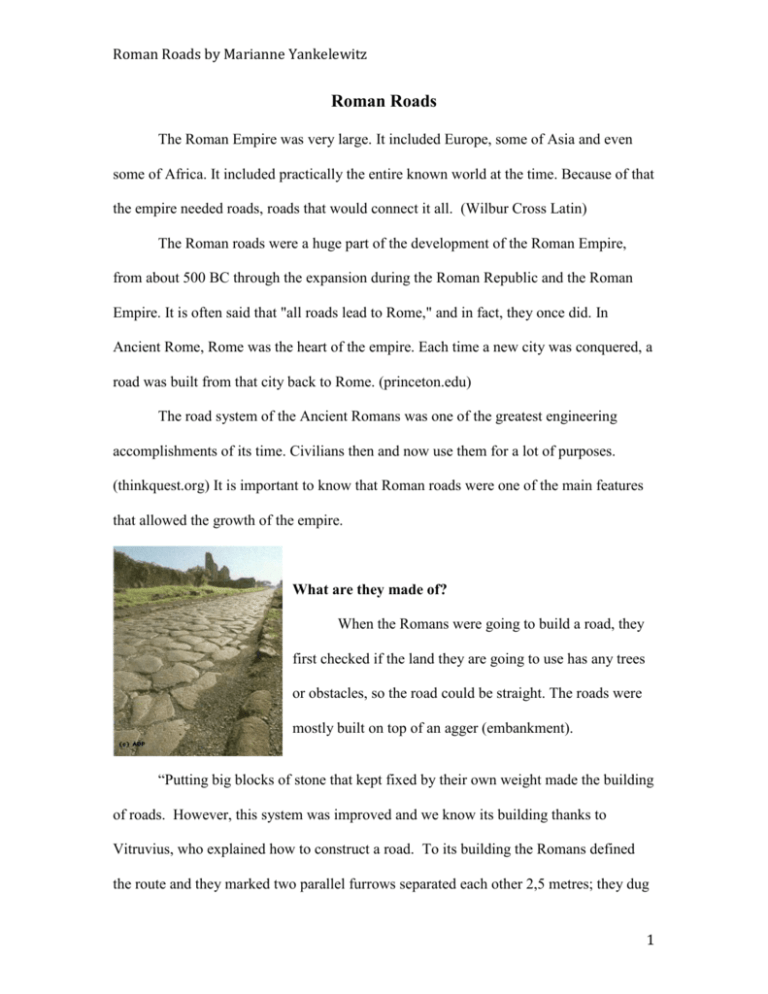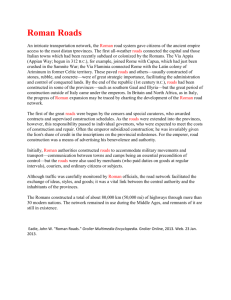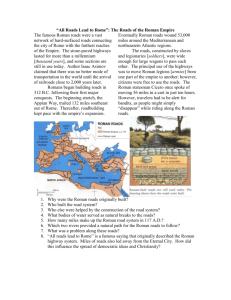Roman roads - Marianne Yankelewitz
advertisement

Roman Roads by Marianne Yankelewitz Roman Roads The Roman Empire was very large. It included Europe, some of Asia and even some of Africa. It included practically the entire known world at the time. Because of that the empire needed roads, roads that would connect it all. (Wilbur Cross Latin) The Roman roads were a huge part of the development of the Roman Empire, from about 500 BC through the expansion during the Roman Republic and the Roman Empire. It is often said that "all roads lead to Rome," and in fact, they once did. In Ancient Rome, Rome was the heart of the empire. Each time a new city was conquered, a road was built from that city back to Rome. (princeton.edu) The road system of the Ancient Romans was one of the greatest engineering accomplishments of its time. Civilians then and now use them for a lot of purposes. (thinkquest.org) It is important to know that Roman roads were one of the main features that allowed the growth of the empire. What are they made of? When the Romans were going to build a road, they first checked if the land they are going to use has any trees or obstacles, so the road could be straight. The roads were mostly built on top of an agger (embankment). “Putting big blocks of stone that kept fixed by their own weight made the building of roads. However, this system was improved and we know its building thanks to Vitruvius, who explained how to construct a road. To its building the Romans defined the route and they marked two parallel furrows separated each other 2,5 metres; they dug 1 the space between the furrows and they filled the hole with four layers of different materials, being the last layer the pavement; the layers were first the statumen (big rolling stones), second the rudus (medium-sized rolling stones), third the nucleus –(crushed stones with small rolling stones) and, finally, the pavimentum orsumma crusta (big plane flagstones). All these layers as a whole were 1 meter deep and the durability and the strength of the road resided in its foundations, its first layer. Nevertheless, every zone needed a thicker or thinner layer of statumen: in Africa and in the mountain passes it was hardly ever used, but in the rest of Europe it was very necessary; in addition, the statumen had to be thicker where there was more traffic in order to not to be damaged. Depending on the ground, the Roman sometimes put trunks in the sides to hold the road structure; this is the case of the marshy zones, for example in Britannia (Ancient Britain).” (catedu.es) Basic Facts The Roman roads used to be four meters wide; although in some events they could be even more than six meters wide. In general, in the access to Rome they were twelve meters wide with a third of the surface dedicated to sidewalks. The builders made the road bug enough to fit a roman chariot with two horses. The roads were built in straight lines, regardless of obstacles. Many roads had gutters. Along the side of the road, the Romans built road signs called milestones. Milestones told how far it was back to Rome. To avoid an accumulation of water on the roads, which could suppose their cavein, the Roman made the roads tilted, so that the rain water evacuated to the outside of the 2 Roman Roads by Marianne Yankelewitz roads and it would not keep the water held up in the middle of the road. They dug a small drainage channel, fossa, in both sides of the road, two or three meters away from the road, without vegetation to accumulate this rainwater. For the same reason, the Romans usually constructed their roads on an agger, one meter high, to eliminate the water and to have a better view of the area when the Roman Army crossed it. (catedu.es) Information Apparently a person could travel from Spain to Greece without stepping of a road. For seven centuries, the building of Roman Roads continued nonstop and were well maintained, until economic decline and external pressure began to give way. By the fall of the Western Roman Empire in 476 AD, the condition of the roads aligned the circumstances of the empire. Many roads fell into disuse, ruined, or disrepair throughout that time. (unrv.com) The engineers and builders of the Ancient Roman Roads built an unparalleled network of roads in the ancient world. They were approximately 50,000 miles of roads throughout the Roman Empire, spreading its legions, culture and massive influence throughout the world. (unrv.com) At the very end of the Roman Empire, The Roman road system spanned more than 400,000 km of roads, including over 80,500 km of paved roads. When Rome reached the height of its power, no fewer than 29 great military highways radiated from the city. Hills were cut through and deep chasms filled in. At 3 one point, the Roman Empire was divided into 113 provinces crossed with 372 great road links. In Gaul, a ancient western roman region, alone no less than 21,000 km of road are said to have been improved, and in Britain at least 4,000 km. (princeton.edu) Types of Roads Roman Roads were classified as how they were made, different uses and sizes. They were different types of Roman Roads. They are 14 general types. One of them is called an Agger, which is a built pass, or a causeway. Another type of a road is an Angiportus, which is an alley, or a narrow street. Callis is a type of road also. It is a footpath, pass and track. Other type of Roman Road is a Clivus, a sloping street. A Crepido is a pavement. An Iter is a route, passage and walkway. Limes are another type, which is a path between a field, boundary line or a frontier line. Another type of them is a Pervium, which is a thoroughfare. A Platea is a normal type of street. A Semita is a path. A Strata was special road, or street, only for vehicles. One of the types are Trames, which is a crossway, by-path, or footpath. The most famous type of roads is Viae, plural of via, which are highways. Last, but not least, a vicus was a city street. The majority of these types were minor, the most used and the most common one was the Viae. The Viae, Latin for “way”, had 4 types of highways. The first one and most common one is the Viae Publicae, which were public highways built at public expense. Another type of Viae are the Viae Militares. They were military highways built by the army at their own expense but they fell into the Viae Publicae. The Actus were minor highways built and maintained by local councils. Finally the Privatae were the private roads built by individuals at their own expense at their own property. (mariamilani.com) 4 Roman Roads by Marianne Yankelewitz Purpose The Roman Roads were used for many things in the past and also today. Even though the Roman road system was originally built to make easier the movement of troops throughout the empire, people then and now definitely used it for other purposes too. In the past, the soldiers marched in the roads toward their battlefield to conquer or fight other republics or empires. A good road system also made it easier for the emperors to control their empire, like messages, orders, and news could be sent quickly. Rome made a great deal of money from trade in Europe. Some of this trade involved transport by sea. More frequently, the Romans used roads. (historylearningsite.co.uk) As well, roads provided quick transportation for materials and allowed the trading to be much easier. (Wilbur Cross Latin) “Roads were built or rebuilt by the Romans throughout the empire in Europe, Asia, and Africa. Many modern roads are laid out on their routes, and some of the old roads are still in use. Examples of Roman roads exist near Rome and elsewhere. Their primary purpose was military, but they also were of great commercial importance and brought the distant provinces in touch with the capital.” (Yahoo) Now, in modern day, it’s used for traveling from place to place, for seeing how did romans travel, or just simply walking for sightseeing. Influence in Modern Day Perhaps one of the most visible signs of Roman Influence in modern culture is the Roman Roads. Before the Roman Empire, roads as we know them today, did not exist. In 5 ancient times there two means of travel, one foot or horseback through the country, and ships. In order to connect the capital to minor cities and make travel easier, roads were built. The Via Appia, Rome’s first national highway, stretched 32,000 miles from the capital to Rome’s southern province of Campania. The construction of these roads was careful and calculated. Measuring tools were used to make sure they were straight, regardless of obstacles. Once a course was laid, a trench was dug and lined with rocks. Then the trench was filled with boulders and sand. Then came a layer of gravel compacted with clay. Finally, thick paving stones were laid, angled to allow water to run off to the sides. These roads were incredibly organized; connecting them to Rome is a way that had been impossible before. When looking at Via Appia, one is struck by the surprising resemblance it has to a modern road. The idea of paving a path from one place to another was not a modern idea, but has been around since ancient times. Whether they are cobblestone or asphalt, roads were a Roman idea that has shaped the way we travel today. (messiah.edu) Some of roads were so well constructed that they are still used by people in this day. Conclusion The Roman Empire was very large. It touched Europe, Asia and Africa. It was a really big empire. Because of that the empire needed roads, roads that would connect it all. Roman roads were made really good. Roman roads were so well made that they lasted for centuries. There are several Romans roads that are still in use today in Europe, for example in England there is a Via in Warwickshire. This road was built in 43 AD after the Roman 6 Roman Roads by Marianne Yankelewitz conquered Britannia. This road and a lot of roads too, were used and it’s used now for transportation. The most famous road was the Via Appia just outside of the city of Rome. It still has the original paving stones. In other parts of Europe they are still a lot of parts of the Roman roads and some sections are well conserved, even some roads are complete. The romans were the first people to build a road and a road system, so without them, we wouldn’t have roads today. They teached us how to build a road and we have used that method of building roads ever since. It is important to know that Roman roads were one of the main features that helped the growth of the Roman Empire. 7 Bibliography: Milani-Santarpia, Giovanni. "Roads in Ancient Rome." Roads in Ancient Rome. N.p., n.d. Web. 26 May 2013. <http://www.mariamilani.com/ancient_rome/rome_building_roads.htm>. Trueman, Chris. "Roman Roads." Roman Roads. N.p., 2000. Web. 26 May 2013. <http://www.historylearningsite.co.uk/roman_roads.htm>. Unknown. "Encyclopedia." Roman Roads. Yahoo, 2009. Web. 26 May 2013. <http://education.yahoo.com/reference/encyclopedia/entry/Romanroads>. Unknown. "Roman Roads - Wilbur Cross Latin." Roman Roads - Wilbur Cross Latin. Wilbur Cross Latin, n.d. Web. 26 May 2013. < https://sites.google.com/site/wilburcrosslatin/Home/culture/roman-roads> Unknown. "Roman Roads." Roman Roads. N.p., n.d. Web. 26 May 2013. <http://www.princeton.edu/~achaney/tmve/wiki100k/docs/Roman_roads.html>. Unknown. "Roman Roads." ThinkQuest. Oracle Foundation, 1997. Web. 26 May 2013. <http://library.thinkquest.org/13406/rr/>. Unknown. "Roman Roads." Roman Roads. N.p., 2003. Web. 26 May 2013. <http://www.unrv.com/culture/roman-roads.php>. 8 Roman Roads by Marianne Yankelewitz Unknown. "Roman Roads." Roman Roads. N.p., 2008. Web. 26 May 2013. <http://www.tribunesandtriumphs.org/roman-architecture/roman-roads.htm>. Unknown. "Roman Roads - Ancient Rome for Kids." Roman Roads - Ancient Rome for Kids. N.p., n.d. Web. 26 May 2013. <http://rome.mrdonn.org/romanroads.html>. Unknown. "Roman Road System." Encyclopedia Britannica Online. Encyclopedia Britannica, 2013. Web. 26 May 2013. <http://www.britannica.com/EBchecked/topic/508316/Roman-road-system>. Unknown. "THE ROMAN ROADS." THE ROMAN ROADS. N.p., n.d. Web. 26 May 2013. <http://catedu.es/aragonromano/roads.htm>. Unknown. "The Types of Roman Roads." The Types of Roman Roads. N.p., n.d. Web. 26 May 2013. <http://ancienthistory.about.com/library/bl/bl_roadtypes.htm>. Wulf, Caroline. "Rome: Yesterday and Today." Rome: Yesterday and Today. N.p., 24 Jan. 2011. Web. 26 May 2013. <http://home.messiah.edu/~cw1272/>. 9 Photo Credits: O'Donnell, Kelly. The Appian Way. Digital image. Roman Roads and the Appian Way. N.p., n.d. Web. <http://www.markville.ss.yrdsb.edu.on.ca/projects/classof2008/chong2/odonnell/r omanroads.htm>. Rothermel, Christopher. Roman Road. Digital image. Roman Technology. N.p., 19 Dec. 2011. Web. 27 May 2013. <http://blog.cvsd.k12.pa.us/titus/2011/12/19/romantechnology/>. 10






